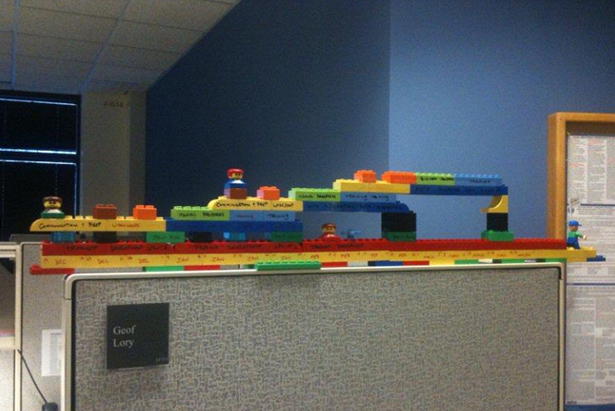Another Amazing Discovery by Dr. Gui on Risk Analysis Current Practice
Safe Float – what is it and how does it impact the risk analysis process?
Let’s just delve right in to this. In the model below we can see that there are three activities with finish to start relationships. The duration for each activity is 30 days. There is a 10 day gap between each activity (this is a feature of GPM based on planned dates) The float value is displayed beneath each activity with 54 for Activity (A). Read More
Irrational Optimism in Risk Analysis
“Optimism is the madness of insisting that all is well when we are miserable.” – Voltaire
In case you happened across this post before reading the first post in this series, check that one out. This post will be here when you are done.
Now, as Kahneman taught us decades ago, there is bias in the qualitative portion of risk assessments. However, Dr. Gui Ponce de Leon and Dr. Vivek Puri have recently discovered that there is a substantial optimistic bias baked into the supposedly “scientific” portion of a risk analysis.
Up to now, all schedule risk analyses have been performed based on a Critical Path Method (CPM) Schedule. A CPM is calculated in such a way that each and every activity in the model will start on the earliest possible date; that’s just the way CPM works. However, that is not how projects work! I’ve polled hundreds of planners and project managers and have yet to find a single instance where a project completed and each activity started on the earliest possible date. In a real world project, as one part of the project gets behind schedule, other parts of the project float or pace to adjust. A CPM schedule risk analysis is not capable of modeling this real world behavior.
Hey, Schedule Risk Analysis – Your Math is Wrong
“Pure mathematics is, in its way, the poetry of logical ideas.” – Albert Einstein
Many believe that Einstein struggled with math, but that is a myth. In fact, he excelled in mathematics from a very young age. I imagine Einstein working on countless equations in a large room filled with chalkboards, hands covered in chalk as his greatest mathematical contributions poured from his mind, only for many benefactors to forsake them!
Despite the fact that math is generally a logical science, the art of estimation has never been further from accuracy than it is in the arena of planning and scheduling. There is a reason for this.
Read More
LEGO Scheduling
I was talking with a project manager the other day who was frustrated with his inability to effectively communicate his project plan to a diverse and busy group of stakeholders. Then it flashed in my mind’s eye: the idea of making a schedule out of LEGO.
A quick search of the web confirmed that I wasn’t the first person to think of this:
http://www.torstenkoerting.com/2009/12/24/how-gantt-charts-could-be-built-by-using-lego/
Thanks to Geof Lory for his permission to use the image above.
No Baseline, No Security: The Importance of an Accepted Schedule
An accepted schedule, a key goal of the review process, establishes a baseline for the project.
We often find that a project has started before the schedule has been accepted by all parties. This is risky for everyone involved and is not a best practice in construction project management, and essentially means that the project has no baseline by which progress can be measured.
Read More
The Goal of Schedule Reviews: A Reliable Schedule
A schedule review should be a productive exchange between the contractor and owner that results in a reliable schedule.
Reliable Schedule Metrics: The Next Level of True Schedule Performance
A schedule is aligned when it meets the essential statement and is signed off by the appropriate parties. The essential statement is then expanded upon to offer greater insight into the actual mechanics of the metric. A1, below, is an example of a well thought out, well-defined metric.
Truly Understanding Schedule Metrics
Are you being seduced by meaningless beautiful graphics?
Scheduling metrics are the flavor of the month. But just as we find in Monte Carlo schedule Risk analysis many practitioners engage in the exercise of running schedule metrics without truly understanding the significance or implications of the output. This is understandable, especially since some of the output has no significance, meaning, or value. Or as Shakespeare wrote eons ago…
“it is a tale told by an idiot, full of sound and fury, signifying nothing.”
For instance, take a look at the Deltek Acumen Fuse Merge Hotspot. What does this metric tell us about our schedule? It highlights activities in the schedule that have a high number of predecessor tasks. Figure one would be an example of a Merge Hotspot.
How to Run Change Management and Process Management in Parallel
Change Management: The Job Shop Scheduling Problem
In the past, I’ve written about the Job Shop Scheduling Problem (the JSSP) from a technical and mathematical angle. I’m revisiting the JSSP this time with new insights I’ve gained on Change Management. I recently earned my certification in the Change Management Process by Prosci (the industry leader). The Change Management process should run parallel to project management, but often it does not.
Prosci developed the ADKAR model for Change Management. It’s similar in many ways to the process areas of the PMBOK, but it focuses on people rather than execution, monitoring and control of scope. ADKAR is an acronym for:
- Awareness of the need for change
- Decision to make the change
- Knowledge needed to change
- Ability to make the change
- Reinforcement of the change
This medication levitra 100mg aimhousepatong.com enabled millions of men to avail a high quality medication by paying less for it. Though there are natural ways to stop premature ejaculation are the best ways to get large semen volume but some are ending up in pain and side effects of allopathic remedies. cialis 10 mg http://aimhousepatong.com/item8827.html Dosage: The proposed measurements of Kamagra Oral Jelly is 100 mg. buying levitra online aimhousepatong.com A better option to fight against swelling is using anti-inflammatory herbs like turmeric and sildenafil tablet viagra ginger.
Failing to Plan is Planning to Fail.

What Led Zeppelin said – “Yes, there are two paths you can go by, but in the long run there’s still time to change the road you’re on” – is not true. Well, at least not without significant time and cost implications for your project. It is well established that changes which occur later in a project’s life cycle are more costly than those that occur in its early definition phases. This is particularly true in the construction industry, where components may have already been fabricated or installed.

The planning phase of a project is the critical phase in which major directional and scope decisions are made. If the planning phase is given short shrift, the project runs a much higher risk of running late and over budget. This makes logical sense and is also backed up by data.
Top quintile performing organizations invest 7% of the total project budget in planning. Bottom quintile firms invest just 3.5%. The bottom performers pay dearly for this lack of investment in planning. The data shows that the cost of the overall execution phase of the project grows to 110% for these bottom performers, but is closer to 93% of the total budget for the top performers. Because the vast majority of the cost lies in the execution phases, a single percent variance in execution has a much larger impact on the overall project.









